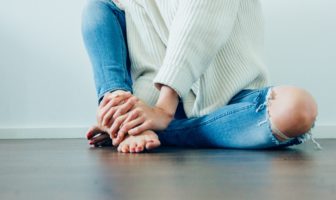Seasonal depression is a real disorder, but it’s only a temporary setback with the right tools.
By Brianna Caleri
Julia Stempko, a certified yoga trainer and wellness marketer who grew up in Round Rock, Texas, already knew she had depression but thought she was backsliding. Living in Portland, Ore., she struggled to convince herself to wake up in the dark fall months and start her day.
“It feels like waking up on the wrong side of the bed and then feeling paralyzed by that negative feeling,” Stempko says.
The yogi learned her worsened depression was directly tied to the changing seasons and found new ways to maintain a balanced life year-round. Now she lives in Austin, where the climate makes seasonal depression less common—although not obsolete—and she makes sure to get outside, maintain her gratitude journal, use an ambient alarm clock for a gentler morning and more.
“I don’t do anything too ritualistically,” Stempko says, “but I do have an arsenal of tools I can pull from to address what I’m feeling.”
Seasonal Affective Disorder, or SAD, is like regular depression, but it only lasts a few months each year. It’s a real, medically recognized mood disorder, and although it can be mild, it can worsen existing depression or be just as severe on its own.
The sunlight we receive from day to day sets biological rhythms and produces hormones that help us sleep an appropriate amount and regulate moods. Sun exposure measurably affects serotonin production, vitamin D production and the functionality of the hypothalamus, which can lead to altered emotional responses. Although SAD is usually associated with a lack of sun in the fall and winter, it can also happen during the spring and summer seasons, when too much sun brings out the more agitated and manic qualities of the disorder, which can accompany depressive episodes. Central Texas’ inhospitably hot summers can also get Austinites feeling down, either because of actual sun intake or because it’s harder to enjoy outdoor activities and get together with friends.
Robyn Zymowski, a licensed professional counselor, puts a special emphasis on the importance of situational factors in depression. Moving from Boston to Austin, she noticed a dramatic decrease in people with seasonal depression, but she knows not to brush off the little things. Signs of depression include social isolation, poor energy and concentration, increased negative self-talk and thought patterns, sleep disturbances and weight change. In contrast, Zymowski says she could spot a manic episode if someone had excessive energy despite a dramatic lack of sleep, was irritable, lacked boundaries, developed addictive tendencies or became obsessed with certain topics.
Those looking for help can turn to several sources. Zymowski suggests first visiting a general practitioner for bloodwork and a check of thyroid activity and vitamin levels. If those results are normal, she suggests sufferers visit a psychiatrist or psychiatric clinic.
Professional help can include light therapy (exposure to special lamps that mimic sunlight) and cognitive behavioral therapy (training a defense against negative thoughts), among endless other therapeutic practices. An even more accessible approach for people with a vitamin D deficiency is available over the counter.
With or without medical guidance, there are hundreds of ways to find more balance and joy in the world every day. People with SAD—and everyone else—can benefit from keeping plants in the house; practicing meditation; limiting tech use, alcohol and processed foods; and especially maintaining a strong network of support. To be that network for someone else, Zymowski recommends simply asking how friends are doing and giving an open, empathetic response.
Most people can relate to feeling sluggish, especially in winter months. Inviting friends out—or even enjoying a movie together at home—can often give them the excuse they need to stop isolating. Thankfully for Austinites, this city is one of the best in the country for getting outside year-round and weathering a not-too-cold winter.

Robyn Zymowski – Photo by Brianna Caleri
FIGHTING SAD
Always be aware. Seasonal Affective Disorder can happen at any time of year, and temporary symptoms can be just as serious as long-term concerns.
Maintain a healthy lifestyle. Stay physically active, see friends regularly and learn positive self-talk. Try tools like meditation, journaling and limiting tech use at night.
Listen to science. SAD is a medical disorder and can’t always be whisked away with positive intentions. Light therapy, vitamin D and antidepressants can provide a much- needed positive push.
Seek help. Different networks can offer different kinds of help. Keep your friends close and understand the specific strengths of a general practitioner, psychiatrist and therapist.




